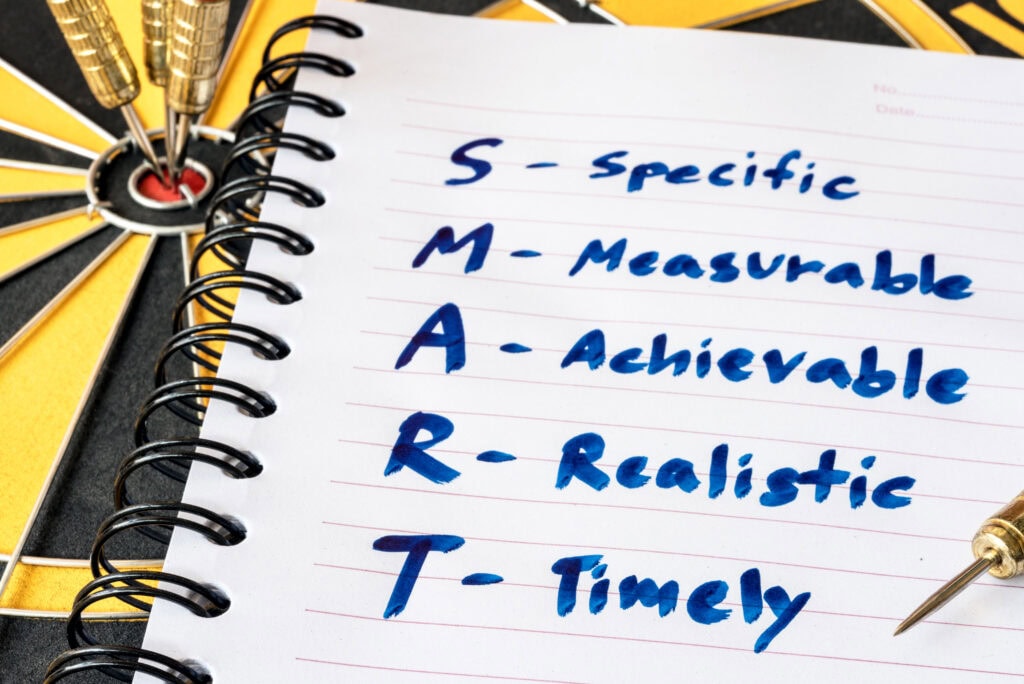Top Tips to Set Goals Effectively and Achieve Success
Struggling to achieve your goals? Learn how to set goals effectively and turn your aspirations into reality. This article will provide you with practical steps and proven strategies to help you create clear, actionable objectives and stay on track.
Key Takeaways
- Effective goal setting involves a structured process that includes defining specific, measurable, achievable, relevant, and time-bound (SMART) objectives.
- Writing down your goals significantly increases your chances of success and helps maintain clarity and motivation throughout your journey.
- Regularly evaluating and adjusting your goals ensures they stay relevant and attainable, enabling you to adapt to changes and overcome obstacles.
Understanding Goal Setting

Goal setting is more than just jotting down what you want to achieve; it’s a deliberate process that involves identifying your accomplishments and establishing measurable objectives to reach them. It is the compass that guides your decisions and actions, helping you navigate towards your desired outcomes.
The process of goal setting is a powerful tool that can help you succeed faster and achieve tangible results. Recognizing the reasons behind your goals enhances your commitment and increases your chances of success.
Understanding the goal setting process and goal setting theory breaks the cycle of ineffective goal setting and puts you on the path to achieving your dreams.
Definition of Goal Setting
Goal setting involves figuring out what you wish to achieve. It also includes creating measurable objectives to help you reach those goals. Unlike casual self-improvement efforts that may lack clear objectives, goal setting involves selecting a specific target and creating a detailed plan to achieve it.
Properly defined goals related trigger new behaviors and focus your attention on what’s important, ensuring that your efforts are directed towards meaningful outcomes.
Importance of Goal Setting
Setting goals is crucial because it provides guidance for decision-making, enhances focus, and maintains motivation. When you set goals, you gain control over your future and acknowledge your desires, which can significantly improve your focus, motivation, and overall productivity. Taking the time to reflect on your goals can lead to a clearer sense of direction. This practice helps you establish a strong purpose in life.
Moreover, aligning your goals with your personal values and passions ensures that they remain relevant and exciting. Establishing specific and challenging goals can lead to increased performance and persistence, helping you make steady progress and improve your success rates.
In essence, goal setting helps you identify what you want to achieve and the actions needed to reach those goals, providing a roadmap to your future.
SMART Goals: The Foundation of Effective Goal Setting

SMART goals provide a structured approach to goal setting, ensuring that your smart goal objectives are clearly defined and attainable within a specific time frame. The acronym SMART stands for Specific, Measurable, Achievable, Relevant, and Time-bound.
By incorporating these elements into your goals, you can enhance your chances of success and maintain consistent progress.
Specific
Being specific when setting a goal is critical for tracking progress and improving the likelihood of completion. Clear goals should answer questions about what needs to be achieved, who is accountable, and the steps required for accomplishment. An example of a specific weight loss goal could be to ‘lose 25 pounds.’ This goal is set to be achieved by the Fourth of July. Similarly, a specific goal for a social media campaign could be to ‘Begin a new social media campaign’.
Using specific terms helps identify the role or objective the goal aims to achieve. For example, a specific goal regarding customer satisfaction might state: ‘Have customers complete satisfaction rating surveys at the beginning of their contract and again after two quarters’.
By providing clear, specific goals, you can create an actionable plan to achieve goals and track your progress more effectively.
Measurable
Measurable goals are essential because they clarify when the goal has been reached, making it easier to track accomplishment. By asking yourself, ‘How will you know when you’ve accomplished the goal?’, you can set benchmarks to measure your progress. For example, if your goal is to increase sales, a measurable objective might be to ‘Increase sales by 20% in the next quarter’.
Measurement provides feedback and insight on progress, which is critical for effective goal setting. Quantifying goals facilitates tracking progress and helps determine when the goal has been achieved. This way, you can maintain your motivation and make necessary adjustments to stay on track.
Achievable
Goals must be realistic and capable of being accomplished within the given constraints and resources. Setting goals that you can control is vital to ensure that you can achieve them, which helps avoid frustration. For example, a realistic goal might be to ‘Complete an online personal finance course in 2-3 weeks’.
Being realistic about what individuals can and can’t directly control when setting goals is crucial. Starting with realistic goals ensures that they are achievable and helps avoid frustration.
Setting attainable goals builds the habit of showing up and making consistent progress.
Relevant
Aligning career goals with personal goals and professional goals ensures they remain meaningful and motivating in your professional life. For example, if your long-term objective is to advance in your career, setting relevant goals like ‘Gain a new certification in the next six months’ can help you stay on the right path.
Ensuring your goals are relevant keeps you motivated and focused on what truly matters.
Time-Bound
Deadlines and specific timelines are essential for maintaining focus and accountability throughout the goal achievement process. For instance, launching a new social media campaign can be a time-bound goal to achieve in the next two months. Setting clear time frames not only aids in keeping goals on track but also enhances your commitment to achieving them.
Deadlines create a sense of urgency and help maintain momentum towards achieving goals. For example, a time-bound goal to increase customer satisfaction within the next two quarters provides a specific timeframe to work within, ensuring steady progress. By adhering to these timelines, you can keep your goals in focus and ensure consistent progress.
Writing Down Your Goals

Writing down your goals significantly increases the likelihood of achieving them. In fact, individuals who write down their goals have a 33-42% higher chance of success compared to those who do not. Documenting goals provides a deeper sense of fulfillment and satisfaction, making it an essential part of the goal setting process.
Benefits of Writing Goals
Documenting goals contributes to increased clarity and helps foster a stronger commitment to achieving them. When you write down your goals, you can stay on track and measure progress more effectively, ensuring you are always moving in the right direction. This clarity and commitment lead to improved success in achieving desired outcomes.
Goal setting involves determining specific outcome goals and creating measurable objectives for success. By writing down your goals, you create a tangible reminder of what you want to achieve, which can help you stay focused and motivated.
Positive Language
When writing goals, it’s essential to use a positive tone. Goals should be phrased as ‘I will’ followed by positive language. Using positive language fosters a constructive mindset, helping you stay motivated and focused on making progress.
For example, instead of saying, ‘I want to lose weight’, say, ‘I will lose 10 pounds in the next three months’.
Creating an Action Plan
An action plan details the specific tasks required to achieve your goals. Many people fail to achieve their goals due to a lack of planning, emphasizing the importance of creating a step-by-step plan to ensure systematic progress.
Including the overall goal and all required steps ensures consistent progress and keeps you on track.
Breaking Down Goals
Dividing larger goals into smaller tasks assists in minimizing feelings of overwhelm. For example, if your goal is to write a book, breaking it down into smaller tasks like ‘Write one chapter each week’ can make the goal more manageable. Using the six W’s (who, what, when, where, why, how) can help break down goals into manageable steps.
Establishing a timeline for goals includes setting deadlines and specific milestones to guide progress. A timeline aids in maintaining accountability. It also helps you stay focused and guides your progress over a specific period. If goals appear too unrealistic, it may be necessary to adjust them or tweak the plan to ensure they are achievable.
Timeline Creation
Establishing a timeline makes you 2x to 3x more likely to stick to your goals. Creating timelines helps visualize important tasks, milestones, and deadlines to maintain motivation. For example, planning specific durations for tasks, like completing an online personal finance course in 2-3 weeks, provides clear guidelines.
It’s crucial to adhere to the dates set within a timeline to ensure consistent progress. Once you’ve set dates in a timeline, you should try to stick to the dates as closely as possible. Following a well-structured timeline helps track progress and maintain momentum towards achieving goals.
Staying Motivated and Overcoming Obstacles

Maintaining motivation and overcoming obstacles are vital for achieving your goals. Consistent progress tracking helps identify both achievements and challenges, aiding in timely adjustments.
Using structured check-ins and goal-tracking applications helps maintain focus and motivation throughout the goal journey.
Identifying Potential Obstacles
Recognizing potential obstacles early is crucial for effective goal setting. Making a note of potential challenges can significantly aid your preparation process, allowing you to devise proactive strategies for overcoming them. Anticipating challenges creates accountability and ensures progress towards your goals.
Celebrating Small Wins
Celebrating small achievements plays a crucial role in sustaining motivation throughout the goal-setting journey. Acknowledging minor achievements along the way boosts motivation and reinforces progress toward larger goals. For example, if your goal is to run a marathon, celebrating milestones like completing a 5k or 10k run can keep you motivated and focused on the big goal.
Maintaining a positive mindset can significantly enhance your ability to stay motivated. By recognizing and celebrating small wins, you can maintain a positive outlook and keep pushing towards your ultimate goals.
Seeking Support
Having a support network can significantly enhance motivation and provide accountability in pursuing goals. Connecting with a supportive network can provide essential encouragement and advice.
Seeking support from peers, mentors, or communities is essential to stay accountable in your goal pursuit.
Evaluating and Adjusting Your Goals

Regular evaluation of goals is essential for staying aligned with your current circumstances. Regularly assessing your goals allows you to adapt to evolving situations and maintain relevance. This process helps you stay focused and make necessary adjustments to achieve your objectives.
Regular Check-ins
Regular check-ins are essential for receiving feedback and maintaining commitment to goals. Reflecting on what went well and what didn’t after accomplishing a goal allows for better future planning. Regular progress tracking, ideally on a weekly basis, keeps you aligned with your goals and allows for timely adjustments.
During evaluations, identify any blockers that may hinder your progress. If you have not achieved your goals within the desired timeframe, review them to see what adjustments are necessary. Self-reflection on past experiences improves future goal-setting strategies and outcomes.
Continuous evaluation and adjustment of goals ensure that they remain relevant to changing circumstances.
Reflecting on Successes and Failures
Reflecting on both successes and failures is essential for continuous improvement in goal-setting practices. Analyzing achievements provides insights into effective strategies and practices that lead to success. For instance, if you successfully completed a project ahead of schedule, understanding what contributed to this success can help replicate these strategies in future projects.
Examining setbacks helps identify obstacles and areas for improvement, which is crucial for refining future goals. Regular reflection on both successes and failures ultimately fosters a mindset of growth and adaptability in goal-setting. Learning from your experiences enhances your ability to set and achieve meaningful goals.
Using Technology to Track Progress
In today’s digital age, technology offers various tools that can streamline the process of tracking goals, making it easier to monitor progress. Goal-tracking apps and digital planners provide structured ways to set, manage, and monitor goals effectively, fostering accountability and ensuring consistent progress.
Goal-Tracking Apps
Many goal-tracking applications feature customizable reminders and progress charts to help users stay on track. These apps can enhance accountability and motivation by providing real-time data on progress, making it easier to assess achievements and areas for improvement.
Popular apps like Strides and Habitica offer flexible tracking methods and gamified experiences to keep users engaged and motivated.
Digital Planners
Digital planners provide structured frameworks that can improve productivity by organizing tasks and deadlines. They can be customized extensively, allowing users to tailor their planning layout to fit personal preferences.
Using digital planners helps track important commitments and ensures you remain focused and proactive in your goal pursuit.
Summary
In summary, effective goal setting is a multifaceted process that involves understanding the principles of goal setting, using the SMART framework, writing down goals, creating an action plan, staying motivated, and utilizing technology. By following these strategies, you can significantly enhance your ability to set and achieve meaningful goals. Remember, the journey to achieving your goals is a marathon, not a sprint. Stay committed, adjust as needed, and celebrate your progress along the way.
Frequently Asked Questions
What are SMART goals?
SMART goals are all about setting specific, measurable, achievable, relevant, and time-bound objectives, making it easier to track your progress and stay motivated. By following this framework, you’ll enhance your chances of success!
Why is it important to write down goals?
It’s important to write down goals because doing so can boost your chances of achieving them by 33-42%. This simple act brings clarity and strengthens your commitment to those goals.
How can I stay motivated while pursuing my goals?
To stay motivated, track your progress and celebrate those small wins along the way. Don’t hesitate to seek support and use goal-tracking apps to keep you on track!
What should I do if I encounter obstacles in achieving my goals?
If you hit obstacles while chasing your goals, it’s crucial to spot them early and come up with proactive strategies. Don’t hesitate to reach out to friends or mentors for support—they can offer valuable help!
How often should I evaluate and adjust my goals?
It’s best to evaluate and adjust your goals weekly to stay on track and ensure they align with your progress. Regular reflection on what’s working and what’s not is key to success.







